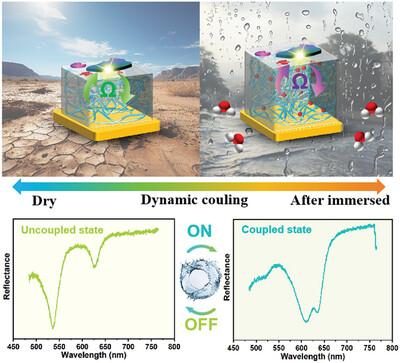当前位置:
X-MOL 学术
›
Laser Photonics Rev.
›
论文详情
Our official English website, www.x-mol.net, welcomes your
feedback! (Note: you will need to create a separate account there.)
Highly Reversible Tuning of Light-Matter Interactions in Van der Waals Materials Coupled with Hydrogel-Assisted Optical Cavity
Laser & Photonics Reviews ( IF 9.8 ) Pub Date : 2024-11-19 , DOI: 10.1002/lpor.202401263
Lanxin Xu 1 , Jiaqi Wang 1 , Zishun Li 1 , Peng Xie 2 , Qi Ding 2 , Minghao An 1 , Yingjie Zhao 1 , Yiheng Tang 1 , Lan Li 1, 3 , Chengchen Guo 1, 4, 5 , Wei Wang 2 , Xiaorui Zheng 1, 3, 5
Laser & Photonics Reviews ( IF 9.8 ) Pub Date : 2024-11-19 , DOI: 10.1002/lpor.202401263
Lanxin Xu 1 , Jiaqi Wang 1 , Zishun Li 1 , Peng Xie 2 , Qi Ding 2 , Minghao An 1 , Yingjie Zhao 1 , Yiheng Tang 1 , Lan Li 1, 3 , Chengchen Guo 1, 4, 5 , Wei Wang 2 , Xiaorui Zheng 1, 3, 5
Affiliation

|
Controlling light-matter interactions via cavity systems manifested by Rabi splitting is paramount important for nanophotonics. However, achieving conveniently accessible and active tuning of light-matter interactions remains a formidable challenge. Traditional approaches often necessitate either sophisticated design or meticulous nanofabrication to address this issue. Here, a handy strategy is experimentally demonstrated to build an adjustable coupling system featuring reversibly modulated responses based on dielectric-hydrogel-metal resonators. By controlling the top tungsten disulfide layer thickness, the flexible manipulation of weak-intermediate-strong transitions in exciton-cavity interactions is revealed on a large-scale hydrogel membrane without nanopositioning or lithography. Crucially, by leveraging the inflation sensitivity of the hydrogel, the coupling strength can be reversibly tailored with excellent reproducibility by modulating the resonator's dry/immersed states. The combined merits of captivating design and daily stimulus render the novel hydrogel-based nanocavities as a groundbreaking step toward the development of active and practical integrated optical devices, such as polariton lasing, switches, and sensors.
中文翻译:

范德华材料中光-物质相互作用的高度可逆调谐与水凝胶辅助光腔耦合
通过以 Rabi 分裂为表现的腔系统控制光-物质相互作用对于纳米光子学至关重要。然而,实现光-物质相互作用的便捷和主动调整仍然是一项艰巨的挑战。传统方法通常需要复杂的设计或细致的纳米制造来解决这个问题。在这里,实验展示了一种方便的策略,以构建一个基于电介质-水凝胶-金属谐振器的可逆调制响应的可调耦合系统。通过控制顶部二硫化钨层的厚度,在没有纳米定位或光刻技术的大规模水凝胶膜上揭示了激子-腔相互作用中弱-中-强转变的灵活操纵。至关重要的是,通过利用水凝胶的充气敏感性,可以通过调制谐振器的干燥/浸没状态来可逆地定制耦合强度,并具有出色的可重复性。迷人的设计和日常刺激的综合优点使基于水凝胶的新型纳米腔成为开发有源和实用集成光学器件(如极化激元激光器、开关和传感器)的开创性一步。
更新日期:2024-11-19
中文翻译:

范德华材料中光-物质相互作用的高度可逆调谐与水凝胶辅助光腔耦合
通过以 Rabi 分裂为表现的腔系统控制光-物质相互作用对于纳米光子学至关重要。然而,实现光-物质相互作用的便捷和主动调整仍然是一项艰巨的挑战。传统方法通常需要复杂的设计或细致的纳米制造来解决这个问题。在这里,实验展示了一种方便的策略,以构建一个基于电介质-水凝胶-金属谐振器的可逆调制响应的可调耦合系统。通过控制顶部二硫化钨层的厚度,在没有纳米定位或光刻技术的大规模水凝胶膜上揭示了激子-腔相互作用中弱-中-强转变的灵活操纵。至关重要的是,通过利用水凝胶的充气敏感性,可以通过调制谐振器的干燥/浸没状态来可逆地定制耦合强度,并具有出色的可重复性。迷人的设计和日常刺激的综合优点使基于水凝胶的新型纳米腔成为开发有源和实用集成光学器件(如极化激元激光器、开关和传感器)的开创性一步。

































 京公网安备 11010802027423号
京公网安备 11010802027423号